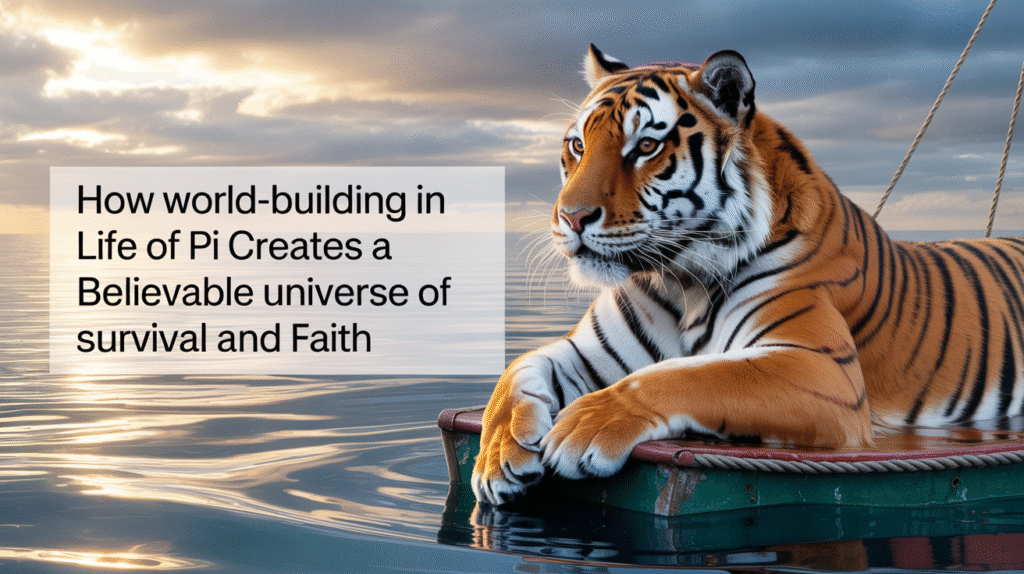The world-building in Life of Pi is subtle but powerful, creating a believable space where a boy can survive with a Bengal tiger while contemplating religion, trauma, and the meaning of life. Yann Martel carefully constructs this universe by establishing physical, emotional, and philosophical rules that readers can immerse themselves in.

Here’s how the novel’s world-building works and why it’s essential for both the story’s plausibility and emotional resonance.
The Setting Follows a Realistic Framework
Despite the fantastical premise, Martel grounds the story in a believable physical world by using real-world geography, climate patterns, and survival tactics.
Real Locations and Logistics
- The journey begins in India and shifts to the Pacific Ocean, with references to real ports, weather systems, and sea life.
- The use of a Japanese cargo ship (Tsimtsum) and Pi’s eventual arrival in Mexico add credibility to the timeline and setting.
Survival Techniques
- Pi’s methods for desalinating water, catching fish, and using the lifeboat are detailed and accurate.
- The author consulted survival guides, making the narrative feel grounded even during surreal scenes.
Psychological and Spiritual Space Is Intentionally Unstable
Martel layers the narrative with shifting moods and surreal imagery that reflect Pi’s mental state, making the world of the book feel emotionally alive.
Floating Island and Blind Castaway
- These surreal episodes challenge the limits of realism, but they fit within Pi’s psychological deterioration and spiritual questioning.
- The floating island, filled with meerkats and acidic pools, is symbolic but still follows its own internal logic.
Dreamlike Sequences
- Long periods of drifting, hallucinations, and spiritual visions create a dreamlike world within the rigid setting of the sea.
- Martel uses these breaks from reality to probe deeper philosophical and moral questions.
Religious Coexistence Defines Pi’s Internal Universe
The rules of Pi’s internal world include a unique spiritual framework where multiple religions are practiced sincerely and simultaneously.
Spiritual Rules of Belief
- Pi follows Hindu rituals, Christian prayers, and Islamic practices without contradiction.
- The novel presents this pluralism not as conflict, but as harmony, challenging the reader to accept a multifaceted spiritual reality.
Faith as World-Building
- Faith shapes how Pi perceives and narrates his ordeal, altering how readers interpret events.
- The “better story” with animals is an extension of this world-crafted to align with a faith-based view of survival.
The Animal World Obeys Symbolic Laws
In Pi’s version of events, the animals on the lifeboat behave in ways that are both naturalistic and metaphorically rich.
Animal Behavior with Symbolism
- Richard Parker acts like a real tiger-territorial, predatory, cautious, but he also embodies Pi’s primal side.
- The hyena’s chaos, the zebra’s helplessness, and the orangutan’s empathy reflect the human traits Pi later attributes to real people.
Rules of Coexistence
- Pi creates boundaries with Richard Parker through training and resource-sharing, mirroring the way humans impose order in uncertain situations.
- The lifeboat becomes a micro-society, with roles, territories, and unwritten rules of conduct.
Time and Space Are Reconstructed by Memory
Martel acknowledges that the story is reconstructed through memory, meaning the “world” is filtered through Pi’s selective recollection.
Story as World Creation
- Pi’s narration admits subjectivity, which makes the world less about objective detail and more about emotional truth.
- Time on the boat becomes fluid-marked not by days but by hunger, fear, and revelation.
Unreliable Narration as a Device
- Because Pi offers two versions of the story, readers are encouraged to question the “rules” of his world.
- This ambiguity invites participation: the reader must choose which version to accept as true.
Consistency Keeps the Fantasy Believable
Even in its most surreal moments, the novel maintains consistent internal logic, which is crucial for immersive world-building.
Internal Consistency
- The floating island, while magical, follows a cycle: day brings life, night brings danger.
- The rules of Pi’s interaction with the tiger never change—he must assert dominance, maintain boundaries, and respect the animal’s nature.
Symbolic Framework
- The novel’s metaphors (the ocean as the unconscious, the tiger as instinct, the island as illusion) are not random, they are structured within the book’s broader message.
FAQ: World-Building in Life of Pi
Here are some questions and answers about the rules and structure of the world in Life of Pi.
Is the world in Life of Pi realistic or fantastical?
It blends both. The physical setting is realistic, but the narrative includes surreal and symbolic elements that challenge strict realism.
How does world-building affect the story’s themes?
It supports themes of belief, survival, and truth by making the reader choose which version of the world-realist or symbolic, they accept.
What makes the island scene believable?
Despite being fantastical, the island follows its own set of rules, making it feel consistent within the story’s internal logic.
Why do the animals behave so realistically?
Martel researched animal behavior, especially in captivity, and blends this with symbolic interpretations of each character.
How does Pi’s faith shape the world?
Faith filters how Pi experiences the world, what seems magical to others is spiritual to him. This belief system structures the world he narrates.
Life of Pi isn’t just a survival tale, it’s a carefully built universe where physical hardship, psychological trauma, and spiritual searching coexist. By establishing consistent rules and layered symbolism, Yann Martel makes this world one readers can believe in, even as it challenges their perception of what’s real.
